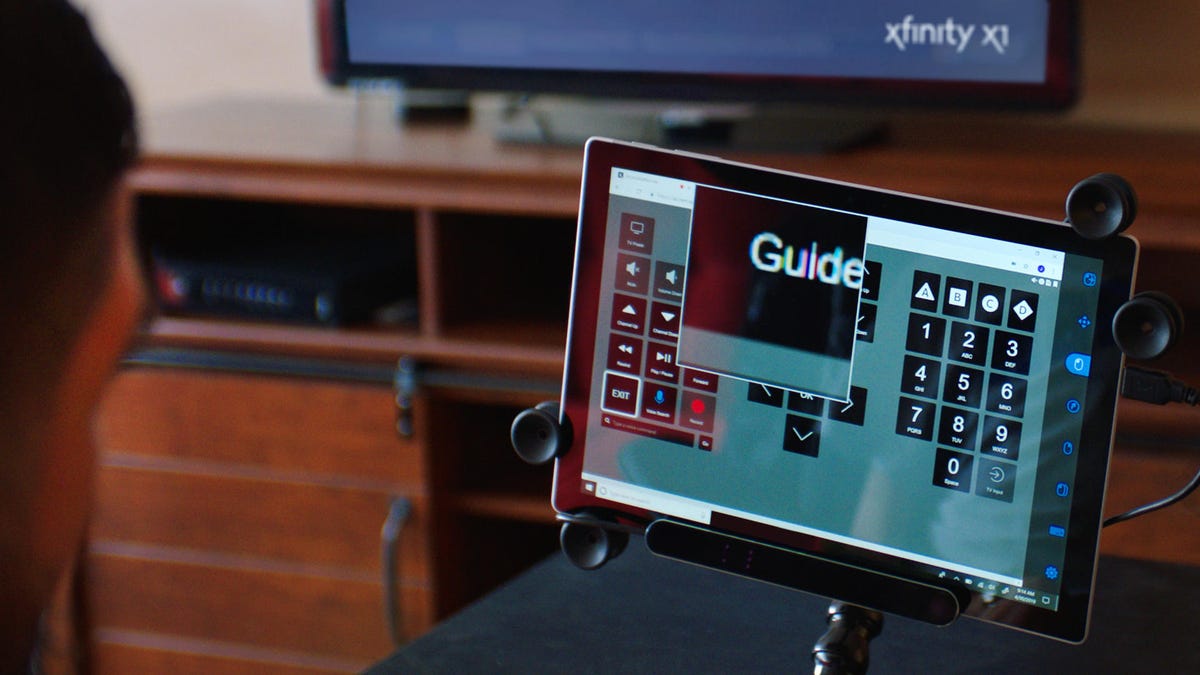Comcast's new remote control lets you channel surf with your eyes
The Xfinity X1 Eye Control can assist people with conditions such as spinal cord injuries and ALS.

Comcast's Xfinity X1 eye control is a web-based remote that pairs with eye gaze systems.
My eyes follow a little cartoon cow from the top left to the bottom right of a Microsoft Surface screen. There's a reason I'm staring so intensely -- and it's not because it's adorable. Both of my pupils are dilated by the act, but in less than five seconds they will be paired with a new virtual remote control system, the Comcast Xfinity X1 eye control.
After this calibration ends, I can now access the virtual keyboard on the Microsoft Surface. By staring at specific buttons on this virtual keyboard in my internet browser, I can flip through different channels on the connected TV behind the computer.
Comcast, the nation's largest cable provider, on Monday released this new virtual keyboard, compatible with laptops and computers, to help you navigate your TV screen with the power of your gaze.
This virtual keyboard is the latest example of how companies are working to make their products and services accessible to the disability community. For instance, at its Worldwide Developers Conference earlier this month, Apple announced Voice Control, an accessibility feature that allows users with motor limitations to browse their iOS devices by simply speaking directions. Similarly, Google at its annual I/O conference in May announced a Live Caption feature that transcribes videos and audio in real time, meant to benefit deaf users.
Comcast's customizable virtual keyboard is accessed via the URL Xfin.tv/access, and it will be available to people with both the existing Comcast Xfinity platform and third-party assistive eye-tracking technology from companies such as Tobi. Customers can use the technology to not only change the channel, but also launch the TV guide, search for content or record a movie.
While the keyboard is available to anyone with the Xfinity X1 cable TV platform and a browser, the technology is intended to benefit people who cannot use their hands well enough to handle a remote control, including people with ALS or spinal cord injuries -- or for those who just need to use a voice-controlled device.
During my trial of the Xfinity X1 eye control, Comcast repeatedly referenced how the product could assist those with ALS, or amyotrophic lateral sclerosis. ALS is a neurodegenerative disease that gets worse with time and causes people to lose control of their muscle movement. There are more than 30,000 Americans and 450,000 in total worldwide with the condition, according to the ALS Therapy Institute.
"Disability isn't a one-size fits all ... We have to be able to spend that time with the customer and understand what they're trying to accomplish," said Tom Wlodkowski, who heads up the accessibility team at Comcast. "And then assess what equipment, what services we have that can line up with their needs ... to deliver the experience they're looking for."
Philadelphia resident Jimmy Curran, who has spinal muscular atrophy, was one of the first to receive the new X1 eye control system.
A keyboard layered with options
The Xfinity X1 eye control system does require some discipline. If you aren't used to the technology, a distracted gaze could mean clicking on the wrong TV channel.
Fortunately, the keyboard is customizable, which means there are options for using your eyes. Instead of using the dwelling feature to select keys based on the length of your gaze, you can opt to blink to make a selection. You can also adjust how long you want to gaze or how much you want to blink for the keyboard to select options
Wlodkowski, who has two decades' worth of creating tech for people with disabilities, says the company's long-term vision with the platform isn't just about making watching TV easier, but using its X1 platform, available in 39 states, to operate a whole smart home .
"X1 is the centerpiece of what we call the operating system of the home ... You can manage your home network," said Wlodkowski. "You can arm, disarm your security system. Our job is to make sure this is as inclusive as possible."
For Comcast, accessibility has long been part of the culture. In October 2013, it opened its first dedicated center for customers with disabilities. Today, the center houses about 90 agents who handle more than 20,000 monthly interactions through calls and email, according to Wlodkwosi. Those with legacy platforms older than the Xfinity X1 can also acquire the service by calling the company's disability customer center.
"It's less about the business opportunity ... You are already paying for a service, let's give you the most out of it," said Wlodkowski.
Correction, 7:43 a.m. PT: This story initially misspelled the name of Comcast's accessibility head. His name is Tom Wlodkowski.

